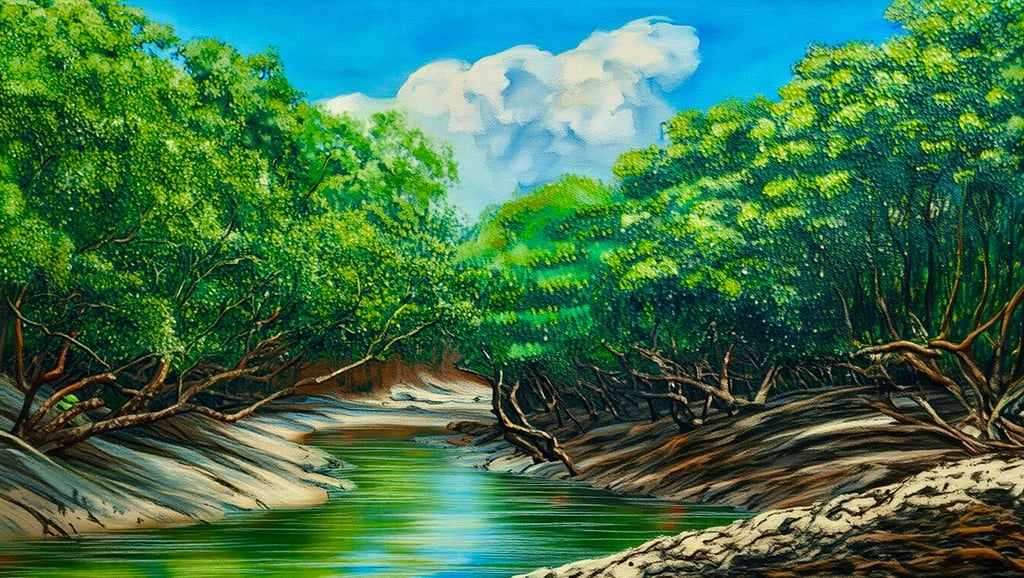The Sundarbans: Where Tigers Tiptoe and Mangroves Reign
Discover the Sundarbans, the world’s largest mangrove forest and a UNESCO World Heritage Site. Explore its Bengal tigers, tidal rivers, unique wildlife, and unforgettable eco-adventures in Bangladesh and India.
ECHOES OF ELSEWHEREASIABANGLADESHINDIAUNESCONATIONAL PARKNATURAL ATTRACTIONNATURE


Sundarbon, Bangladesh
There are forests, and then there are forests that feel like they are plotting against you with cunning roots and saltwater secrets. The Sundarbans, sprawling across the delta of Bangladesh and India, belongs very firmly in the latter category. This UNESCO World Heritage Site is the world’s largest tidal mangrove forest, a labyrinth of waterways where nature runs on its own cryptic clock and the Bengal tiger patrols with aristocratic swagger. It is a place where land and water blur into one vast, shifting wilderness and where survival is both an art and a spectacle.
A Forest on the Edge of Land and Legend
The Sundarbans is no ordinary woodland. Imagine 10,000 square kilometres of tangled mangrove roots, tidal rivers, mudflats, and islands that appear and vanish like shy dinner guests. The forest is a living contradiction: both wild and fragile, both hostile and protective. Its very name is said to derive from the “sundari” trees that dominate the mangroves, although “sundar” in Bengali also means “beautiful,” which feels like a wink from the landscape itself.
This is not just a forest you walk into with a picnic basket. It is a biosphere where crocodiles sunbathe like grumpy old kings, mudskippers dance their peculiar ballet on the riverbanks, and spotted deer move delicately as if they are aware the world’s most efficient predator could be lurking behind any trunk.
Getting There Without Losing Yourself in the Mangroves
The Sundarbans is best accessed from Khulna or Mongla in Bangladesh, or from the fringes of West Bengal in India. Boats are the default mode of travel. Once you’ve clambered aboard a launch, expect a world where maps are more suggestive than accurate and where every bend in the river looks uncannily like the one you passed fifteen minutes ago. That is part of the charm: you are surrendering to a waterlogged maze that has humbled kings, explorers, and Google Maps alike.
Where to Stay: Settling Into the Silence
Do not expect five-star opulence. Instead, think rustic lodges in buffer zones, modest eco-villages, or boat stays that rock you to sleep with the tide. The point here is not thread count but immersion. You stay on the periphery of civilisation and let the mangroves remind you what true quiet sounds like. Evenings are best spent under mosquito nets, sipping tea that is as sweet as the locals are welcoming, while listening to jackals call from somewhere in the shadows.
Things to Do (Other Than Avoid Becoming Lunch)
Cruise Like a Crocodile: Glide along the waterways in search of rare Irrawaddy dolphins or the occasional estuarine crocodile, whose smile has far too many teeth for comfort.
Tiger Tracking, Patiently: Spotting the Royal Bengal tiger is the crown jewel of a Sundarbans visit. You are more likely to hear a rustle or glimpse paw prints in the mud than to see one up close, but that is the suspenseful beauty of it.
Birdwatcher’s Paradise: From kingfishers flashing like sapphires to the endangered masked finfoot, the avian population here is so rich that even non-birders may find themselves uncharacteristically excited by wings.
Mudflat Stomping: Explore exposed tidal flats at low tide. The sensation is a strange mix of walking on pudding and being swallowed by the Earth, which is precisely the fun.
Village Encounters: Visit small communities that exist in delicate balance with the forest. Here, honey collectors and fishermen share tales that blur fact and folklore with the confidence of natural-born storytellers.
Why the Sundarbans Still Matters
Beyond its intrigue and adventure, the Sundarbans plays a colossal role in climate resilience. Its mangroves act as storm buffers, soaking up cyclones like nature’s green shock absorbers. It is also a carbon sink of heroic proportions. Yet it is a fragile giant, under threat from rising seas, industrialisation, and the very climate it helps to protect us from. Visiting here is not just about ticking off a UNESCO box, but about understanding what is at stake when one of Earth’s most extraordinary ecosystems is imperilled.
Final Thought
The Sundarbans is not for those who crave predictable comforts. It is for the curious, the patient, and the slightly reckless who want to immerse themselves in a world where tigers vanish into shadows and rivers refuse to flow in straight lines. Come here to be humbled, and leave with shoes still crusted in mud and a story that sounds half like myth and half like confession.




